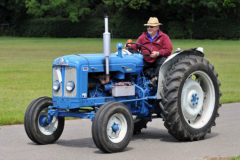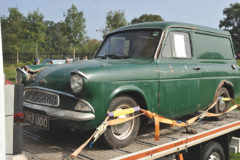Mouth-watering road steamers!
Posted by Chris Graham on 1st November 2021
Jeremy Martin’s invitation event saw a gathering of mouth-watering road steamers, steam portables and other interesting vehicles.

Making its rally debut in Roger Luck’s ownership is the AW Smith No. 136 made in Glasgow circa 1860… Roger Pridham completed the new boiler assembly on 1 January 2006, it features a later-style tube cluster to help the engine’s steaming.
For decades steam portables have been the forgotten part of the steam preservation movement and have been late to the party. In fact in the 1960s Alan Duke of the RLS supported by WS Love and some others felt details of steam portables did not need recording, which caused quite a kerfuffle at the time even with WS Love’s young son.
But attitudes have changed and they are very much part of the scene today with small portables in great demand, helped by many from South America and other parts of the globe coming back to the UK in container loads, particularly in the 1990s.
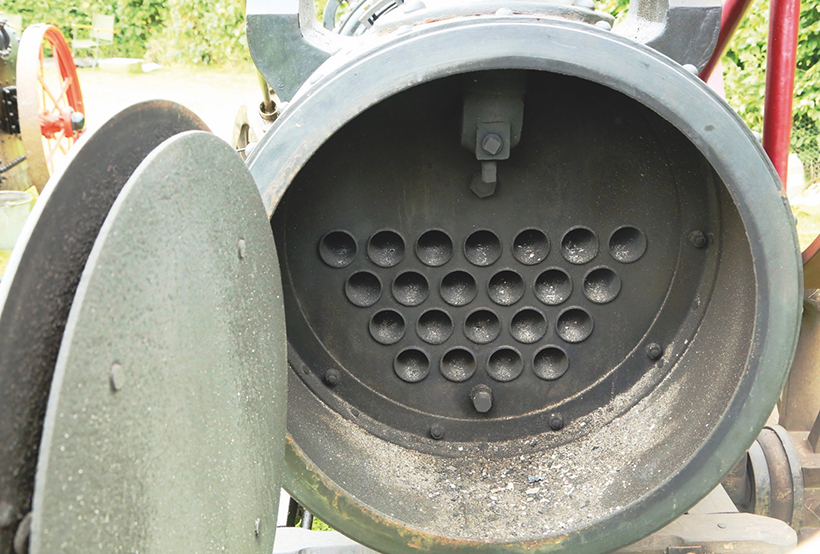
… Roger Pridham completed the new boiler assembly on 1 January 2006, it features a later-style tube cluster to help the engine’s steaming.
When I was looking for a small portable in the early 80s it was very difficult to find any but the late Bill Briggs successfully lead me down a road that turned out to be very fruitful.
As I arrived on site all I could think about was my first experience of being taken to see a portable coupled up to a rack bench not far from here in 1956. Dad had collected me from Pembury hospital, where I was stationed for some months, in his gold column-change Standard Vanguard. On that trip he took me to Harry Bridgeland’s premises I believe at Fern Lea near, Marden.

The water pump body of the A W Smith engine and the fittings into the boiler.
Bridgeland’s had lots of engines in their timber business during steam working times, including 1917 Fowler No. 14925 TE2 Russian type that we all know today as Windrush. On that day the ex-Lambert Marshall portable engine was painted up well, but for whatever reason father didn’t take any pictures as he chatted to Harry. It certainly made an everlasting impression on me, that’s for sure.
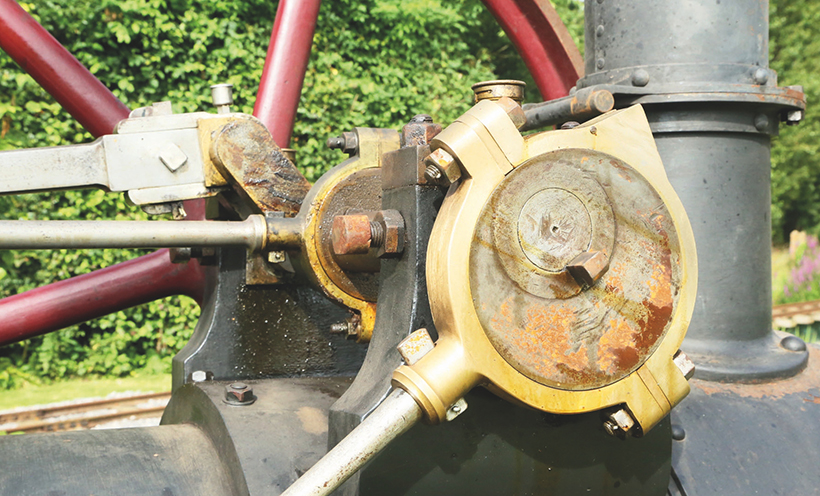
The brass pump rod eccentric strap on the crankshaft is an interesting affair.
Moving on, 65 years later one of the main collectors of steam portables in the UK today is Roger Luck of East Peckham who has a great passion for these fascinating machines. He has built up an excellent collection as time has gone on, particularly the rarer examples.
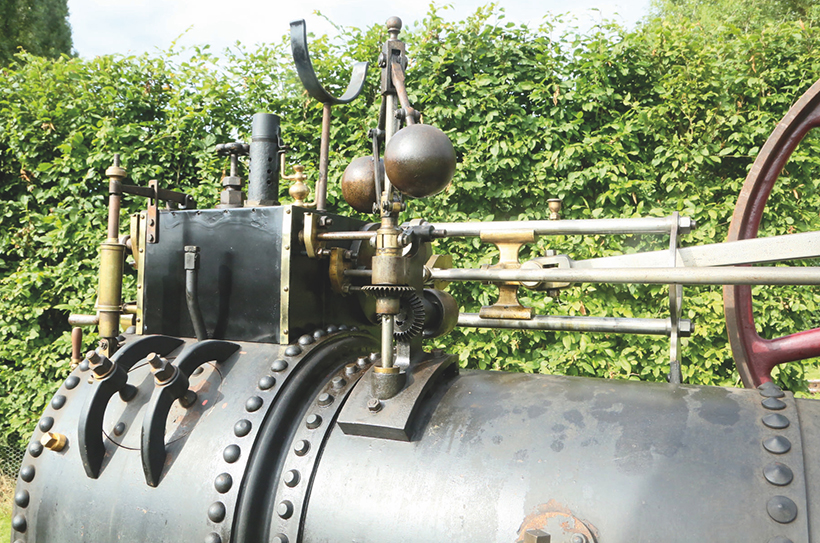
Watts cross arm governor with sifter valve and regular valve tap.
Owing to the ground conditions only the lighter portables could be placed on the lawn. Visitors were greeted with a line of four of them which certainly made an impressive sight.
On the left stood the amazing c.1865 Barrows No. 316, a 6hp engine. It certainly looked very Victorian and has been through so much since the late 1980s. I first remember the engine in Colin Tucker’s ownership. He was a fine blacksmith and teacher from Bexleyheath. He was as pleasant a person as you could find and full of enthusiasm. The task of rebuilding the boiler and a bit more was carried out by Billy Hedges at the Chatham Dockyard in the 1980s.
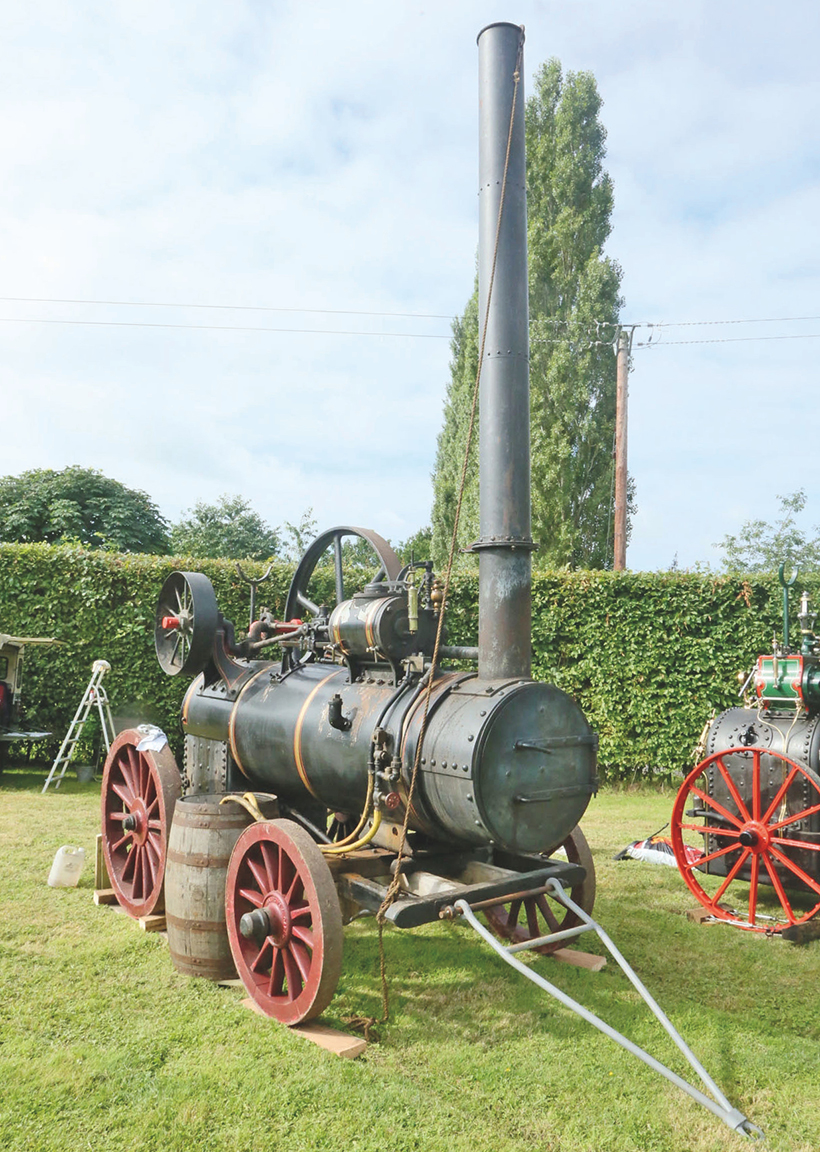
Looking rather different to most portables with the cylinder at the front is the 1868 Barrows No. 316.
Being originally made of wrought iron it created problems, but a double-riveted skirt was placed around the backhead and much other work in other areas saw this amazing engine come back to life. It made its debut at the Southern Counties Historic Vehicle Preservation Trust’s first Blindley Heath rally venture where the writer gathered a number of portables together to make a special display of them, possibly back in 1988. Later in the engine’s life it ended up with Adam Marriott who 11 years ago now had the boiler barrel replaced and tubeplate replaced by Allison Engineering – the barrel is made in two halves and was double-riveted. The smokebox is single-riveted as original. The engine has an interesting regulator mechanism that starts off through the rear wrapper plate and ends up at the cylinder through some cheese wheels, which had to be replaced during Adam’s ownership.

The cylinder on the Barrows is on the front end of the engine, Fowler had a similar arrangement.
Just a few years ago now the engine came back to Allison Engineering for its 10-year test when owned by Rob Gambrill before it has ended up in Roger’s collection,- it was making its public debut at the Richmond event.

As can be seen the Shackle’s 1973 Land Rover is an immaculate piece of kit.
At the other end was the engine everyone fell in love with, the c.1860 A W Smith of the Eglinton Engine Works, Glasgow No. 136, a 2.5hp portable which steam engineer Brian Hope was in charge of for the day. Only a few have ever seen this fascinating engine. It resided in Cornwall for many years and carries a brand new boiler assembly created by Roger Pridham in 2006. This engine is also part of Roger Luck’s collection today and was another making its debut here.

Jim and Helen Shackle with Brian Hope, who all had a great day with the engines at Richmond.
Apparently father Smith had a considerable reputation as a maker of agricultural, corn, flour and saw mill machinery in his works at Paisley. The year before he passed away in 1838, his sons Andrew and William had set up together as agricultural and general engineers. It is said their first major piece of engineering under this arrangement was a 16 x 30in steam-driven sugar mill for Tobago in the West Indies. In 1855 the brothers moved into larger premises at Tradeston, Glasgow and called it the Eglinton Engine Works.
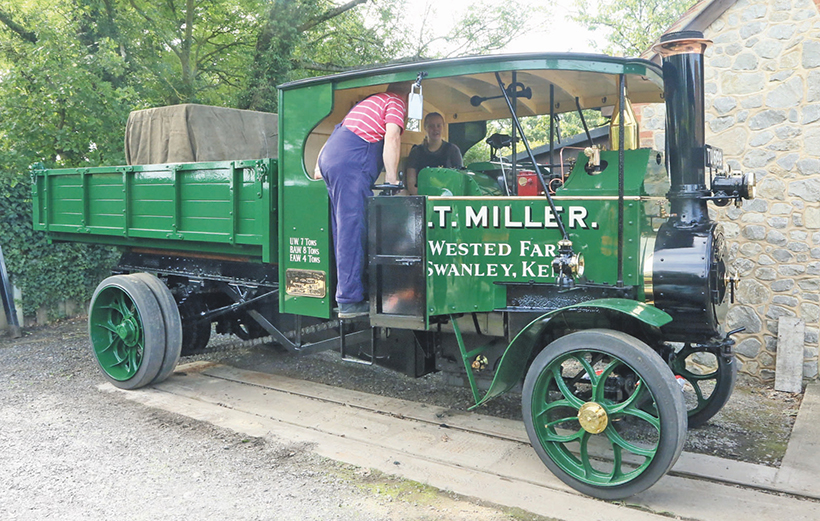
Cleaning is a never-ending thing when owing a steam engine, as Bob and Lucy Moorman are finding out!
Here they specialised in the manufacture of sugar machinery much of it for W & A McOnie, engineers of Glasgow, who had sub-contracted work to Smith’s for oxen-driven sugar mills. At the same time the works made bridge and structural steelwork for locomotive sheds and buildings besides railway wagons and weighbridges. In 1869 the company produced its first tank locomotive for Robson Maynard & Co, Middlesbrough. Various tragic things happened within the Smith family with one or two fall-outs along the way as well. In 1896 they became a limited company as A & W Smith & Co Ltd; their first chairman was the Rt Hon John Wilson, MP.

Looking superb in its refreshed original livery is the Hazlehurst’s Sentinel SDDG4.
The late 1920-30s saw the sugar machine industry struggle owing to the Wall Street crash and the following world depression. Interestingly a 500hp horizontal steam engine from this period, supplied to CSR Goondi Mill for crushing sugar cane, is preserved at the Australian Sugar Industry Museum, Mourilyan, Queensland of this period.

Looking immaculate, Jeremy Martin’s 1927 Fowler DNA No. 16948 Colleen.
However Smith’s survived through diversification to some degree and acquired the power hammer business of R G Ross & Sons Ltd. To survive the 1930s the company even made Loudon machinery planers for Russia, and took out a licence for sandslingers for foundry use.
After WW2 Tate & Lyle Ltd, took them over in 1953, but kept their name as others around them in the industry collapsed and Smiths acquired the goodwill of most of their former rivals. In 1967 Smith became part of Mirrlees Watson Co Ltd, and traded as Smith Mirrlees until acquired in 1988 by Fletcher & Stewart Ltd, sugar machinery manufacturers at Derby. The Eglinton Works closed in the late 1980s and was the last sugar machinery manufacturer in Scotland.
The Smith engine features new rear wheels and carries a most interesting cylinder block and regulator circular valve arrangement, which needs a bit of time to understand its intricacies. For road steam fans it was one of the major highlights here that’s for sure.

Looking good, Roger Luck’s 1910 Clayton & Shuttleworth No. 43069 8hp portable.
Next door was the delightful ex-South African ‘baby’ 1923 Ransomes, Sims & Jefferies No. 34240, another 2.5hp engine. It looks a real treat now, but when Stephen Brett purchased the engine from Preston Steam Services it was well worn. Alec Hume at Heathfield rebuilt the boiler assembly with a new barrel and more including a foundation ring. The fittings were totally rebuilt by Brian Hope and the very desirable engine looks the part now in the ownership of Roger Luck; it was being run by Brian Hope on the day.
In the middle of all of this was another wonderful engine making its debut on the rally scene – Jim and Helen Shackle’s ex-William Balfour Co, Santiago, Chile Marshall 3hp, number unknown.
Before they bought the engine the boiler work had been completed, including half a barrel and all the usual items that go with a boiler rebuild. But the owner then gave up – the engine didn’t have a flywheel or crankshaft which can be such a daunting task to sort out. Edd Jones loaned this happy couple his Marshall 3hp flywheel to copy which was cast by Bridport Foundry. As for the SG iron crankshaft this was made by Boro Foundry Ltd in Stourbridge – all easier said than done! The trunk-guide was bored out and the crosshead, which does not feature adjustable slippers of course, was white-metalled and scraped in.

With the needle off the stop 1905 Marshall portable No. 44110 has started to make steam. It’s been restored to perfection by the Hazlehurst’s for over 10 years now.
A new piston and valve rod went on and much of the brass fittings were re-manufactured and so it went on. The end result is just wonderful and to see the 125psi engine in steam and ticking over so well with the correct livery was a wonderful pleasure for the punters here.
What finished off the engine so well was the chimney spark arrester cleaner, for which all the mechanism is intact and something lacking on so many export Marshalls. The Shackle’s have a saw bench to go with the engine, which they will use at local shows, in between carrying on the rebuilding of their lovely 1903 Burrell No. 2613 6hp single Brenda, which is a long-term project.
Out on the hard standing area were two more portables. Firstly the Hazlehurst’s 1905 6hp Marshall No. 44110 engine that was new to Chile. It looks so well after a remarkable restoration – the whole boiler assembly was made in Vicky and Colin’s back garden with much help from various visitors! As Vicky says, it cost quite a lot in early morning breakfasts she provided over the years to do it, but it was all worth it in the end. No. 44110 was completed ten years ago now and looks as just as good as when it first appeared and works well on the saw bench.
Secondly was Roger Luck’s first portable restoration in the form of 8hp single Clayton & Shuttleworth No. 43069 that was dispatched on 13 August 1910 to Chilean agents Rose & Innes of Valparaiso. It worked for 90 years driving a saw mill before in 2003 Jeremy Martin brought it back to the UK with others. Compared to many of the engines brought back it was in good condition. The lagging was full of sawdust when removed!
Purchased by Roger in 2003, it was given the restoration treatment with new tubeplate, firebox repairs, tubes, smokebox, chimney and spark arrester, plus much more and finished off in the correct C/S livery in 2009. It was in 2013 the NTET presented Roger with the Jack Holloway Bowl for portable engines. This engine is not for the faint hearted and was looking as splendid as always.
Moving on to self-moving engines, we had Jeremy’s December 1926 ex-Tyrone County Council genuine convertible Colleen which was converted back to its original status by Freddy Forrest in Scotland decades back and looked immaculate as always, as it quietly steamed around.
Looking rather different to how I remember it, but all the same looking immaculate now and carrying a stained wood canopy, was 1930 Aveling & Porter AD No. 14039 10 ton compound roller Canterbury of James Taylor and John Maynard. In fact they were part of the railway crew operation on the day and Canterbury was under Peter Denham’s stewardship, who also had his Ford Model T pick-up also looking very clean.
Bob Moorman and his daughter Lucy were here with his superb ‘restoration of the year,’ the ex-Kings 1927 Foden No. 12630 The Leader 6 ton wagon that’s going so well. The other steam lorry here was the Hazlehurst’s 1930 Sentinel SDDG4 No. 8448 making its proper public debut with its new boiler assembly and paintwork all back to its original owner’s livery, which is nothing but spectacular. The following day the waggon appeared at the Weald of Kent event and travelled on the road at some speed – this unique Sentinel is a tribute to its owner’s work on it.
The last to arrive was Will Day who steamed over from Headcorn with his fine 1920 Mann No. 1425 dog cart Little Jim for the day’s events. There were some fine i/c machines dotted around the site from a Bentley 4.5 litre and a very interesting Belgium FN to a lovely turquoise Morris Minor 1098cc convertible. It was certainly a day to remember – these more intimate events can mean so much more than bigger events that’s for sure.
For a money-saving subscription to Old Glory magazine, simply click here



